 by
Lynn Salmon
by
Lynn SalmonHow does one get involved with counting penguins? Like many people, I find penguins amusing and fun to watch. So when presented with an opportunity to spend time up close and personal with the little creatures, I eagerly volunteered to join a group doing a survey of the population of Little Penguins (Eudyptula minor) on Gabo Island, which is located just off the coast of Australia near the border where Victoria meets New South Wales. This will be one of the first extensive counts of the penguins on Gabo Island. However, the people I will be going with have conducted similar counts on Montagu Island in years past.
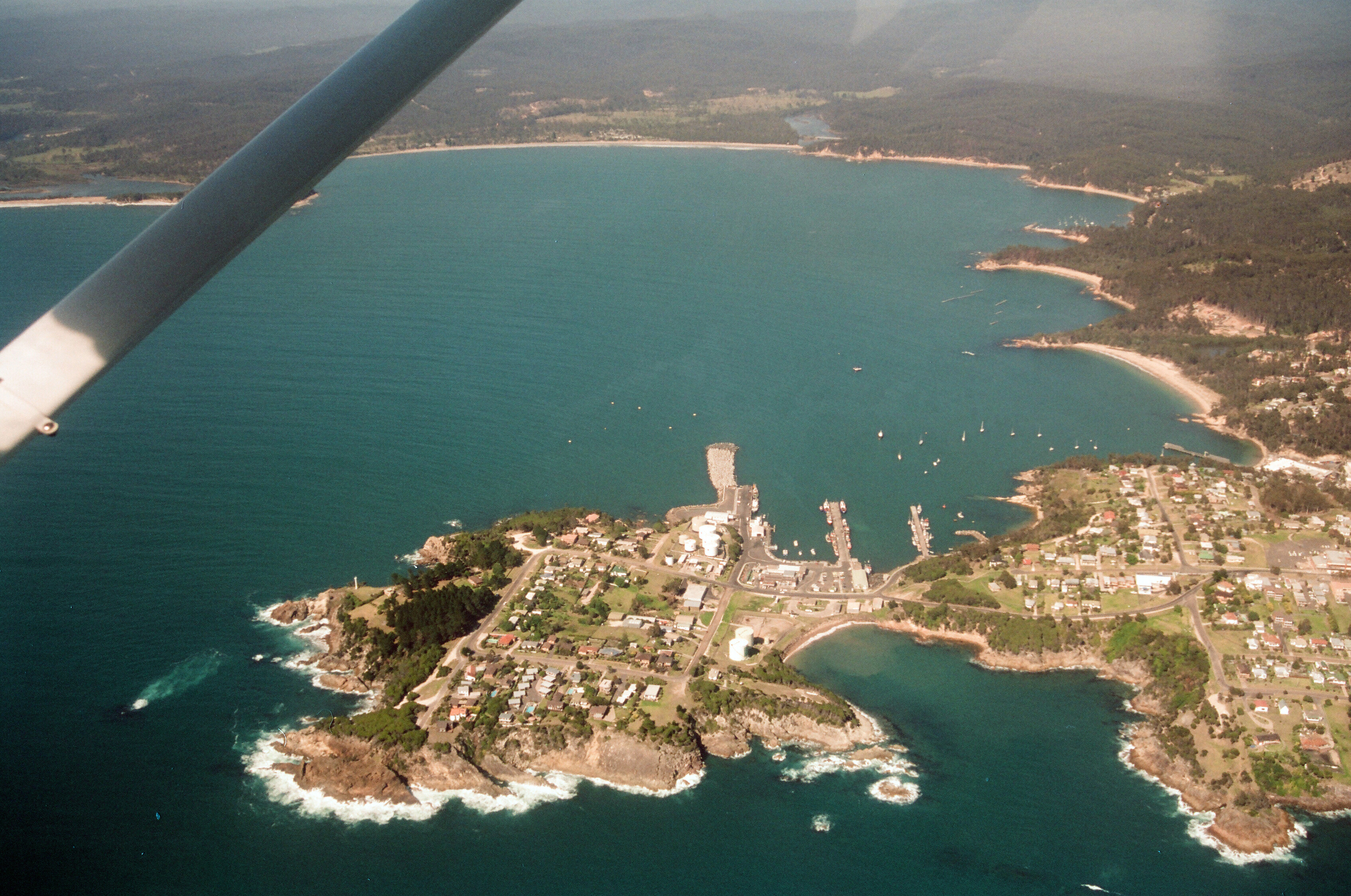 John and I took a short holiday before he
dropped me off in Mallacoota to join the penguin expedition.
We drove down the coast stopping in the town of Eden, pictured left,
the first
night and then continuing on to Victoria. We visited
the Croajingolong National Park and had a very picturesque
dining experience with our camp stove at Betka Beach.
After locking the keys in the car,
we learned that a mechanic can get our car door unlocked
quicker than John could set his stopwatch to time the process.
John and I took a short holiday before he
dropped me off in Mallacoota to join the penguin expedition.
We drove down the coast stopping in the town of Eden, pictured left,
the first
night and then continuing on to Victoria. We visited
the Croajingolong National Park and had a very picturesque
dining experience with our camp stove at Betka Beach.
After locking the keys in the car,
we learned that a mechanic can get our car door unlocked
quicker than John could set his stopwatch to time the process.
Rain, rain go away, come to Mallacoota some other day. The weather wasn't very cooperative, but we explored some walking tracks near Mallacoota while waiting for the rest of the group to arrive. The beginning of the walk was pleasant passing through pittosporums, but we didn't spot the rare Mallacoota gum which was supposed to be along the track we followed. Most of the beach walk was nice, though slow going slogging along in the sand. There was a group of three pied oystercatchers also taking a walk along the beach. We found a nice grouping of rocks to sit on, but cut our lunch short due to ominous looking clouds and lightning in the distance toward Shipwreck Creek camp area. We headed back to the hotel and ate our lunch there instead.
I did get a first look at Gabo Island, soon to be my home away from home for the next three weeks. Gabo is located ~10km north of Mallacoota, approximately 1km from the mainland. It's not very large, 2 square km in area, with approximately 6 km circumference. We could see the lighthouse at the south end of the island. We also saw one dead fairy penguin washed up on the beach. Alas, one less to count.
Around 7pm we connected with most of the other penguin people and got dinner at the pub. At dinner I learned that Short-tailed Shearwaters (also called Mutton Birds) Puffinus tenuirostris take a long trip up to Kamchatka, and occasionally down into Alaska, but make their way back to the same nesting sites each year and all of the birds will lay their eggs in a two day window expected around November 25 this year. While a penguin count is our primary goal, we will also be noting any shearwaters found on the island. These birds also nest in burrows and occasionally occupy vacant penguin holes.
Our penguin group is being led by Dr. Peter Fullagar [photo, lower right]. He's the only one I've met in advance since I know his son Dave. The rest of the group consists of:
 We got going early and had some fun loading some big stuff into
a small boat which had its exciting moments.
We took along a
4 wheel drive motor bike and a trailer that had to be pushed up ramps
and into the boat. The boat's cargo area was only slightly larger than
the trailer which required a lot of manipulation to make things fit.
Fortunately, there was a crane at the dock on Gabo Island, so unloading went
more smoothly.
We got going early and had some fun loading some big stuff into
a small boat which had its exciting moments.
We took along a
4 wheel drive motor bike and a trailer that had to be pushed up ramps
and into the boat. The boat's cargo area was only slightly larger than
the trailer which required a lot of manipulation to make things fit.
Fortunately, there was a crane at the dock on Gabo Island, so unloading went
more smoothly.
There was quite a bit of spray, and waves
periodically washed across the back of the open boat on the trip to
Gabo causing us to arrive a bit damper than we had left.
We briefly met
the light keeper, Pat Howell, his wife Judy, and two of their three
sons who came out to meet us in the drizzling weather.
We are also being joined by two of the Park
Service employees, Morris and Phil, who have some of their own penguin
counts to do on the island and will be with us for a couple of days.
Our accommodations are in two of three houses originally used
when there were three full time keepers stationed on the island.
Now, there is only one light keeper, Pat, who occupies one house.
In the past, it was one keepers job to fire rockets during periods of
fog. Three rockets had to be fired every 15 minutes instead of having
a fog horn.
Each time we find a nest we usually pull out the penguins. Most often,
we find two chicks, but sometimes there will be an adult sitting on eggs or with small
chicks. One person acts as vegetation mapper and records the type of vegetation found
along the transects, takes soil depth readings every 50m, and notes grade of the slope.
They also note the location of each of the burrows and what was found
including the ages of the chicks, depth of the burrow, etc. The tough
part is fighting the way through brambles and heavy scrub when it is
in the measuring area.
We have, I believe, 19km total length to cover in this manner.
Banksia and tea-trees are found in the higher areas in the center of
the island. Pig-face, heath and tussock grassland predominate
in the lower areas with kikuyu grass growing as a weed.
Around mid-morning, the light keeper's son, Sean,
ran in and said, "Whales!". So we all ran out. There were at least
four humpback whales, two large whales and two calves, playing in the
surf in plain sight from the lighthouse porch. I saw them for about 15
minutes doing their leaping ballet through the water. Peter also saw
an albatross and a black faced cormorant and offered everyone a look
through his telescope. Pauline echoed popular sentiment when she
said, "Stuff the cormorant, I want to watch the whales."
"We're laughing now." We went out about 11am and finished the
transects we started yesterday and then started working on
transect #3. I skipped out at around 4pm and came back to take a turn
making dinner. We seem to be well provisioned, thanks to Mike's
advance planning. Theres a lot of meat in the freezer, plenty of custard,
several casks of wine, bread, fruit, vegetables, cheese, and more.
With so much wine on hand, I decided to make
beef bourguignonne. It
took a long time to simmer so I baked some Puffin brand chocolate sponge
puddings that weren't too bad considering they came from a box.
We also have another variety of "self-anointing" sponge pudding cakes
that come in cans.
A hard day, transect 5 (we're doing all the odd transects first)
was about 2km long and went through dense bushes and low trees.
Crash, crash, bang into one tree branch after another.
Many bruises, but miraculously no ripped clothes from the blackberry
brambles.
Pauline had a dizzy spell and some chest palpitations and decided
to go back early since a boat was coming today. She, fortunately,
felt fine before the boat arrived. I can't say the same for my back,
which couldn't take one more bend down and grope around under the bush
after about 2pm. Otherwise, it was a beautiful day, around 80F, and
since we were in the middle of the island with all the trees, we
didn't get too much sun.
There were a handful of penguins up in all the dense scrub.
It must be quite a chore for them to get up there since it is
quite a chore for us, and our legs are longer. I think the
preliminary estimate from the data so far is 22,000 pairs, but
transects 1-3 covered a very populated penguin area so the count
is expected to go down. Phil left us today and was replaced
by Rod, also from the Park Service. Both he and Morris will
leave in two days, however.
Alas, no turkey
available for the traditional turducken
we make at Thanksgiving, and I made hamburger casserole instead.
I got the easy job of recording the data while Nick and Morris
pulled out the penguins, and Jamie measured them. Some of the
new vocabulary I learned are: gonys - bump on the bottom of the bill;
and culmen - spot at the head end of the bill typically 30-40mm from
the tip; other measurements performed were bill depth at nostrils,
bill width at nostrils, and length of head plus bill (typically 90mm).
Jamie referred to a lot of them as being
"aggro". I'm not sure if this is aggressive or
aggravated, but both adjectives fit the mood of a fairy penguin
after an encounter with a long arm dragging it from its burrow.  After lunch, we went out
to work on laying the first transect at about 3pm. We split
into two teams to work on two parallel transect lines 100m apart.
A map of the island has had 12 transect lines marked out, spaced
at 100m intervals running North-South the entire length of the island.
Transect work involves finding the transect you are on with
the aid of landmarks from aerial photos of the island and laying
out 100m reels of measuring tape along the line of the transect.
Then the area one meter on each side of the tape is thoroughly
searched and each and every penguin burrow is noted along
with the contents no matter what the terrain. In the end, each
penguin counted will represent 50 penguins, and the total will be
estimated with corrections for terrain and other factors.
After lunch, we went out
to work on laying the first transect at about 3pm. We split
into two teams to work on two parallel transect lines 100m apart.
A map of the island has had 12 transect lines marked out, spaced
at 100m intervals running North-South the entire length of the island.
Transect work involves finding the transect you are on with
the aid of landmarks from aerial photos of the island and laying
out 100m reels of measuring tape along the line of the transect.
Then the area one meter on each side of the tape is thoroughly
searched and each and every penguin burrow is noted along
with the contents no matter what the terrain. In the end, each
penguin counted will represent 50 penguins, and the total will be
estimated with corrections for terrain and other factors.
 Pulling the chicks out of the hole can also be
a challenge. I managed to get a hold of 4 or 5 and spotted a few eggs
and a couple of nests too deep to "grope". For the deep holes, Nick
Klomp has a camera on a flexible arm to poke down and take a look.
This is the first time it has ever been used, and it has a few bugs in
the system. I got to aid in its repair work with the trusty phillip's
head attachment on my Swiss army knife. Never do field work without
one. Nick brought duct tape, another field work necessity, which was used to attempt a later
repair to the camera system.
Pulling the chicks out of the hole can also be
a challenge. I managed to get a hold of 4 or 5 and spotted a few eggs
and a couple of nests too deep to "grope". For the deep holes, Nick
Klomp has a camera on a flexible arm to poke down and take a look.
This is the first time it has ever been used, and it has a few bugs in
the system. I got to aid in its repair work with the trusty phillip's
head attachment on my Swiss army knife. Never do field work without
one. Nick brought duct tape, another field work necessity, which was used to attempt a later
repair to the camera system.
Day 2 (November 22, 1994) THAR' SHE BLOWS!
Day 3 (November 23, 1994) HARD WORK
Days 4-5 (November 24-5, 1994) THANKSGIVING
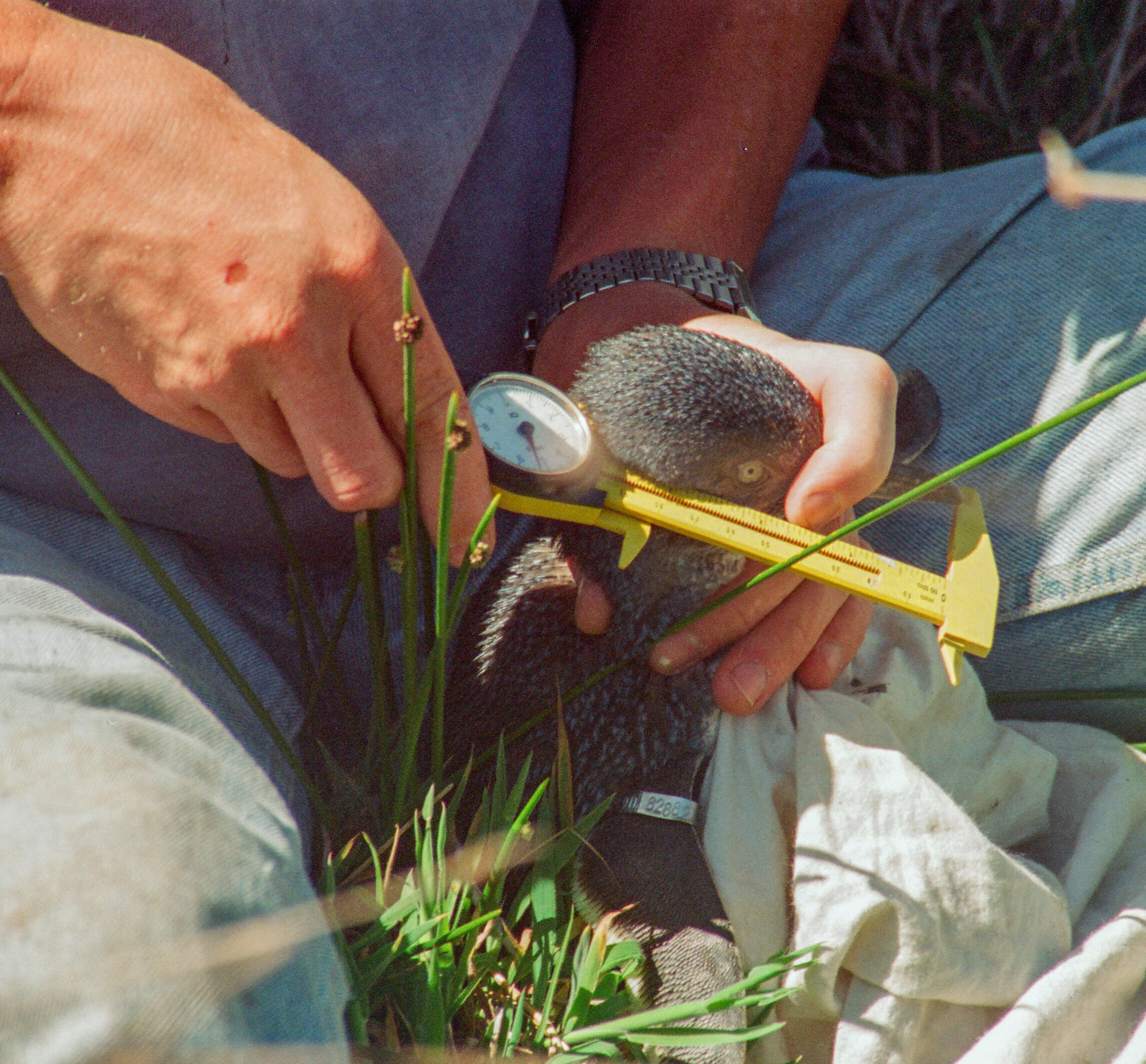 The Park Service people have set up some marked areas in
densely populated penguin regions and periodically survey all
the burrows in their marked plots. Jamie and I spent a morning banding any of
the birds found in these plots. Jamie just finished
his honors thesis with 11 months of penguin diet studies on
Montagu Island and will probably be continuing for a Ph.D. with
more work on penguins. He has a Little Penguin banding license
and wants to band at least 100 birds while we are at Gabo.
The banded birds get a numbered, stainless steel bracelet
put around the right flipper.
The Park Service people have set up some marked areas in
densely populated penguin regions and periodically survey all
the burrows in their marked plots. Jamie and I spent a morning banding any of
the birds found in these plots. Jamie just finished
his honors thesis with 11 months of penguin diet studies on
Montagu Island and will probably be continuing for a Ph.D. with
more work on penguins. He has a Little Penguin banding license
and wants to band at least 100 birds while we are at Gabo.
The banded birds get a numbered, stainless steel bracelet
put around the right flipper.
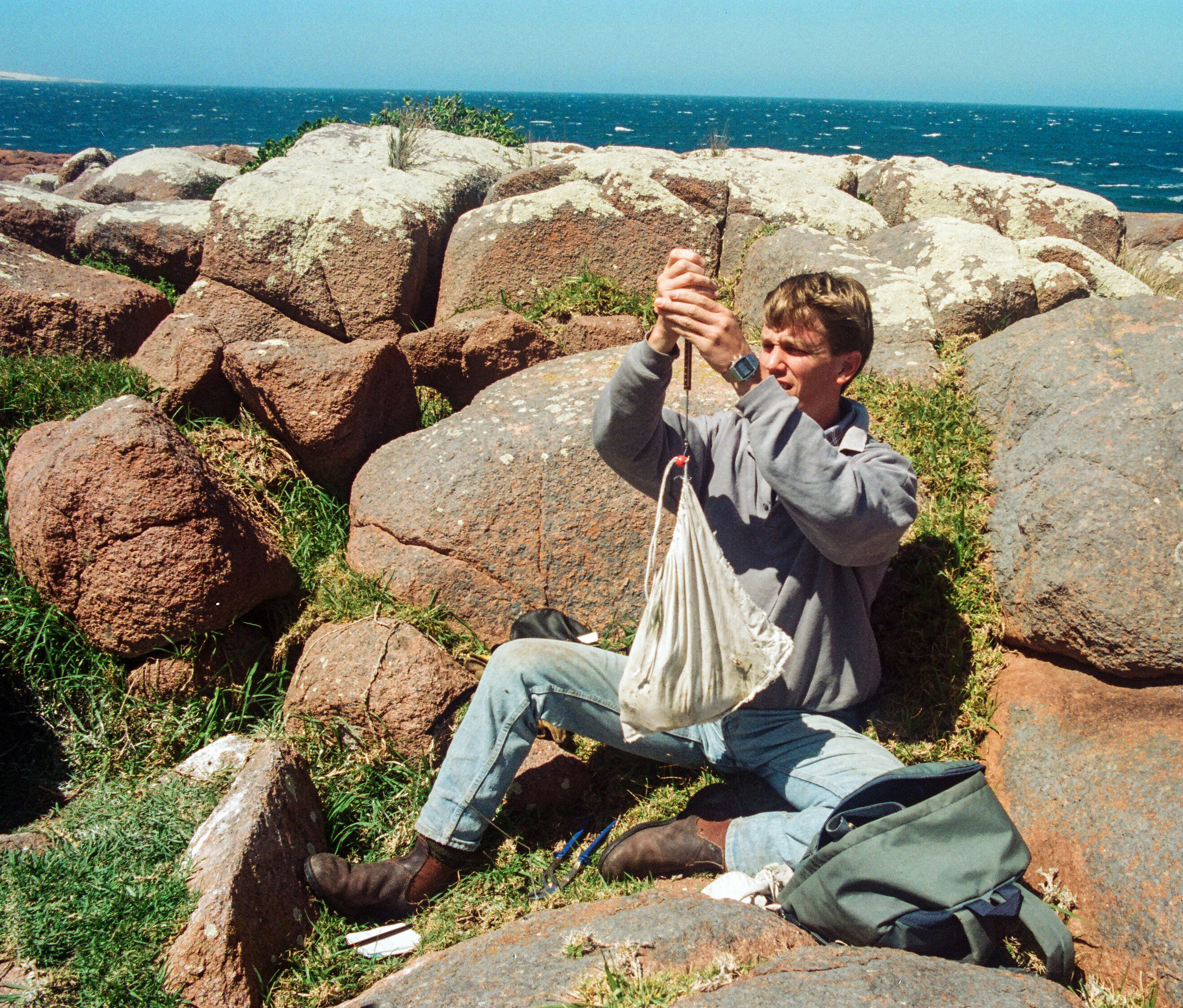 Today I did bird weighing which is accomplished by stuffing the
penguin in a canvas sack and hanging it from a scale (Jamie is shown
doing it in the photo). I guess
the sack sufficiently resembles a burrow that the penguins don't
seem to mind hanging out in the bag too much, even though the
sacks were occasionally
hung on the fence with penguins waiting to have their measurements taken.
The birds weighed today were in the range 0.9 to 1.525 kg after
subtracting the bag weight.
The hardest part of the morning was the ride up and back in
the trailer attached to the motor bike with Rod driving like
Evel Knevil all over the island.
Today I did bird weighing which is accomplished by stuffing the
penguin in a canvas sack and hanging it from a scale (Jamie is shown
doing it in the photo). I guess
the sack sufficiently resembles a burrow that the penguins don't
seem to mind hanging out in the bag too much, even though the
sacks were occasionally
hung on the fence with penguins waiting to have their measurements taken.
The birds weighed today were in the range 0.9 to 1.525 kg after
subtracting the bag weight.
The hardest part of the morning was the ride up and back in
the trailer attached to the motor bike with Rod driving like
Evel Knevil all over the island.
Next, the teams regrouped to attack transect #7. Up and through the bush. It took us from 9am-2pm to hack our way 1.5km through the blackberries, banksia, tea-trees and other scrub. It gives me new appreciation for the term overland. Transect #7 runs through the center of the island, so there weren't many birds. I managed to pull a couple of them out of their holes near the end. The adult penguins fight and bite all the way. Not to mention what they do with their other end.
Nick Klomp was left back at the lighthouse for one last ditch effort to repair the penguin scope before he left us on Friday along with the Park Service people. Nick was replaced by his student, Nicole who is also called Nik.
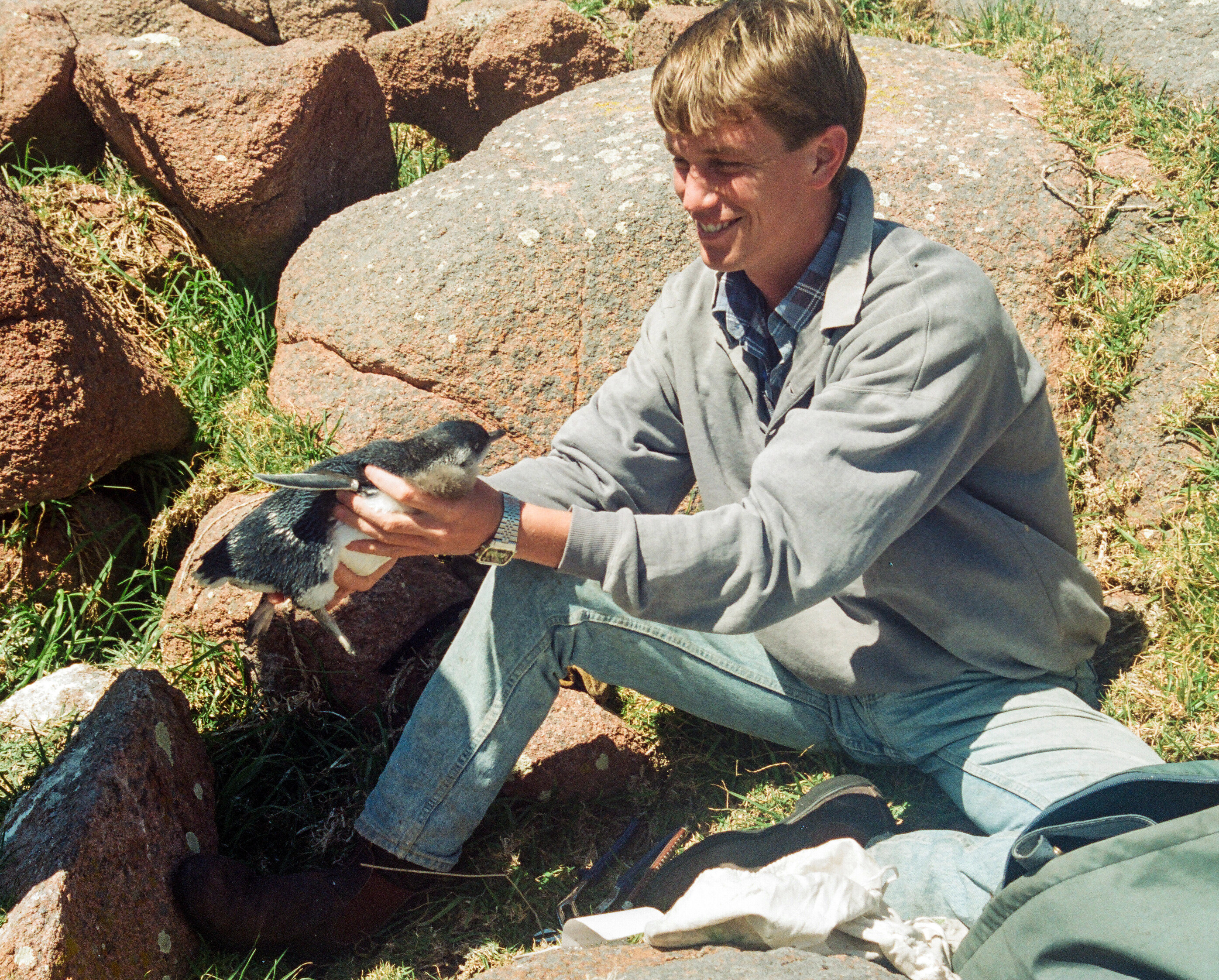 We had an easy day doing the two shortest
transects, #11 and #12 located near the lighthouse.
One transect ran through Pat's house, but he wasn't
harboring any penguins under his bed.
We've now completed all of the odd numbered transects on the
island and have come up with an updated estimate of 19,500
pairs of penguins.
We had an easy day doing the two shortest
transects, #11 and #12 located near the lighthouse.
One transect ran through Pat's house, but he wasn't
harboring any penguins under his bed.
We've now completed all of the odd numbered transects on the
island and have come up with an updated estimate of 19,500
pairs of penguins.
Tonight was our first penguin landing count. Little penguins tend to stay out to sea all day, sometimes for multiple days at a time, and return to their burrows in the evening just after sunset. They tend to stick to the same landing site day after day and counting them come ashore is another way to get an estimate of the population. It's also a lot of fun to watch them waddle in together as half a million visitors annually witness at the Penguin Parade on Phillip Island. That spectacle is just the penguins naturally coming in for the evening as they did before the lights, fences, and PA system were installed for the tourists.
Gordon and I chose our vantage points at two different penguin landing areas on the west side of the island. These are easily recognized by the whitewash trails leading up from the sea. Initially, I was worried that no penguins were going to land at my spot because nothing happened from 7:30 until 8:16pm when the first penguin swam in and landed. It took another 20 minutes or so before more started coming and it began to be hard to keep count. They like to collect in little groups and then charge in with an occasional straggler staying behind to join the next group. Counting becomes a matter of counting all those in a cluster area and trying to subtract those that continue on and then recounting the cluster to see if new ones have joined the group.
While waiting for the penguins, I also got to see a lot of shearwaters flying in, coming very close to where I was sitting. It was the big egg laying day for them so we should start finding shearwaters on eggs occupying abandoned penguin burrows starting tomorrow. In all, I counted 62 penguins before Gordon signaled time to head back. Jamie and Nik together were at a really huge landing site on the north end with over 600 penguins coming ashore. That's about the same number of birds that come in to the Penguin Parade at Phillip Island. Prue had only about 40 and Gordon 322. Peter and Mike counted 80 and 100, respectively at sites near the lighthouse.
We had a very late dinner cooked by Mike, but it was excellent. He marinated chicken in soy sauce, honey, ginger, onion, garlic, and a little red wine while we were out counting penguins, then simmered it in the frying pan when we got back. Dinner was accompanied by Peter's CD, Sound Portrait of an Island - Montagu, Island of Birds . This is an ABC audio release that was produced by Ederic Slater and Peter Fullagar in 1992. It contains a segment of sounds that one would hear at night when the penguins are coming ashore. They make a lot of noise in the evenings when they are active, as we get to experience first-hand. [Penguin braying sound file]
The days are beginning to blur together and the day of the week, or the date isn't very meaningful except for the data sheets. The pace has altered dramatically from the all-day ordeals last week. It is quite pleasant, and we were able to lounge around at the lighthouse part of each day and are treated to humpback whales displaying for us.
Prue, Jamie, and Nik attempted to go swimming, but found the water too cold. The temperature doesn't bother Pat a bit, who dives in and has gotten abalone for us a few times. We've had the fresh abalone, just quickly fried in a little oil for an appetizer at dinners and it was great. Sometimes Gordon coats it with crumbs, and I've also tried a bit raw, and it's been good each time.
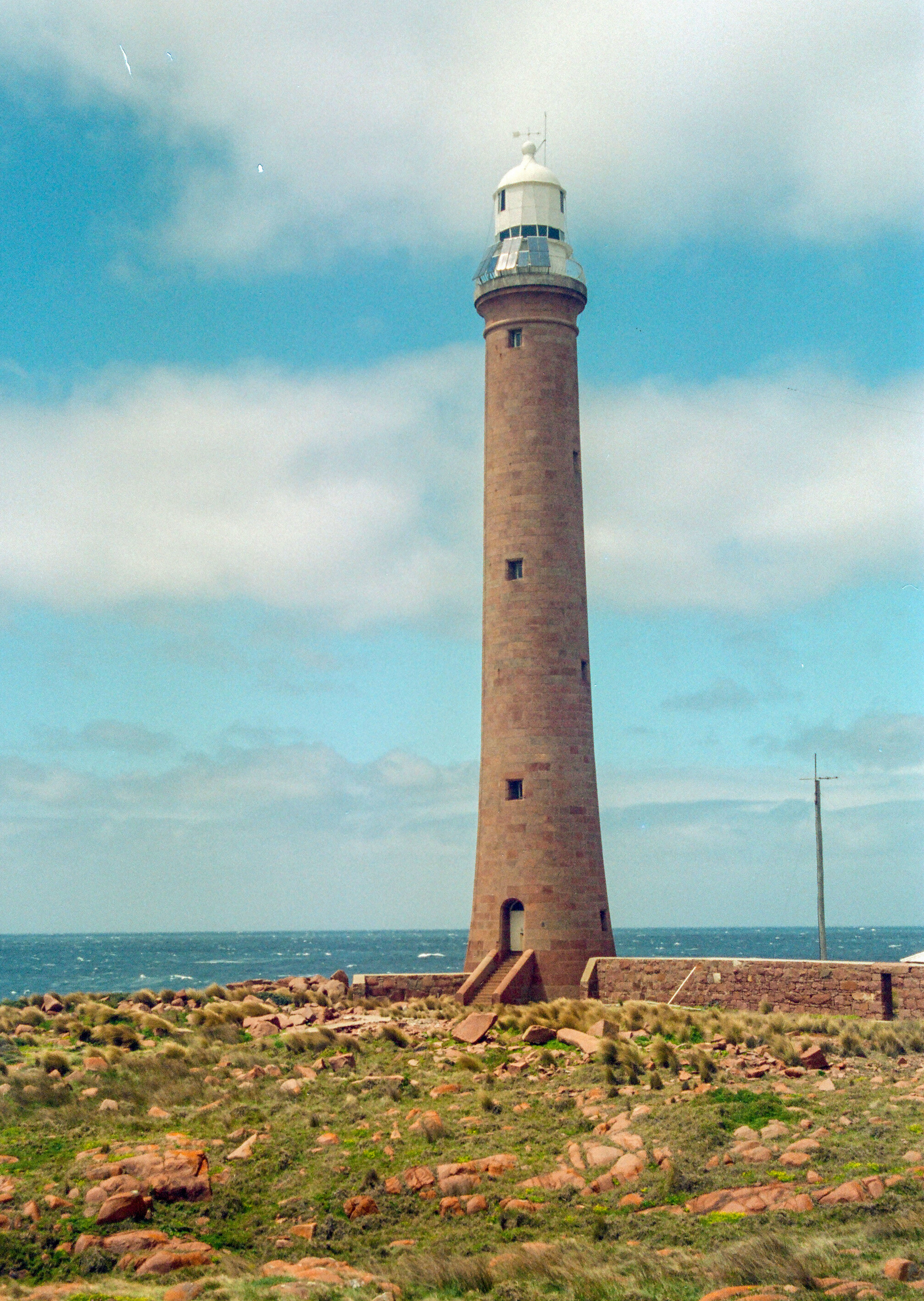 During some free time, I looked through
articles written about Gabo Island that Peter
brought along. Among them was, "An Archaeological
Survey of the Coast From Cape Howe to Wingam Point Including
Gabo Island" by Richard Fullagar, a postgraduate student
in the Prehistory Dept., Latrobe University.
The paper contained some general information
about the island.
The Gabo lighthouse was built
using granite quarried on the island.
Evidently the granite on the island contains
red biotite and is famous for its use as a building material.
I counted 212 steps in the lighthouse when
I went up to the top of it.
There are also two granite huts, purportedly built by early
sealers. We came across one of them when doing transect #10.
During some free time, I looked through
articles written about Gabo Island that Peter
brought along. Among them was, "An Archaeological
Survey of the Coast From Cape Howe to Wingam Point Including
Gabo Island" by Richard Fullagar, a postgraduate student
in the Prehistory Dept., Latrobe University.
The paper contained some general information
about the island.
The Gabo lighthouse was built
using granite quarried on the island.
Evidently the granite on the island contains
red biotite and is famous for its use as a building material.
I counted 212 steps in the lighthouse when
I went up to the top of it.
There are also two granite huts, purportedly built by early
sealers. We came across one of them when doing transect #10.
Pat also had some documents pertaining to the island including The Gabo Island Light station Conservation Plan. The first lightkeeper was George Tapp and his son, C.J. Tapp published his recollections in The Age, 4 August, 1934. The current granite lighthouse was designed in 1859 and began operation in late 1862.
Gabo Island ( latitude 37o 34.1' S; longitude 149o 55' E) is a dangerous feature on a dangerous coast and has been the site of many shipwrecks. I've listed a few below.
 We put in a final push to complete the
hard transecting work.
Jamie spent a lot of time bashing through thick scrub
with a sickle, severing one of the meter tapes.
Our final day was
beautiful with excellent weather, and we
had lunch in the field.
It felt pretty good to know the hard work
was wrapped up, though
there are plans for more evening penguin
counts and also shoreline mapping of the landing sites.
We put in a final push to complete the
hard transecting work.
Jamie spent a lot of time bashing through thick scrub
with a sickle, severing one of the meter tapes.
Our final day was
beautiful with excellent weather, and we
had lunch in the field.
It felt pretty good to know the hard work
was wrapped up, though
there are plans for more evening penguin
counts and also shoreline mapping of the landing sites.
On the second night of penguin counting I hit the jackpot with 526 birds and a peak 15 minute period of 198! I had taken my camera along planning to take a few flash pictures in the lulls, but I never got a lull. Jamie, on the other hand, had only 4 birds at his sight. We also retrieved a badly banded penguin who's flipper had been cut up by the metal band. It had been banded by some other person quite some time ago judging by the low number. The Australian Bird Banding Scheme keeps the records and one reports sightings of banded birds to them so the information will be transmitted to the original bander. Jamie extracted the band and recorded the bird's weight and measurements before releasing it without re-banding it. The bird was very fat and should be fine.
At night, the place is alive with the sounds of penguins coming ashore and scampering along their paths. The chicks come out of the burrows and stand crying to be fed. We've continued the nightly penguin counts each evening. Since the penguins like to use the road at night to get to their burrows, they make it nearly impossible to drive. It is even hard just to walk along the road at night without stepping on an occasional penguin. One night Pat tried to pick us up with his truck after a count, but Gordon and Mike had to keep getting off the truck to shoo birds out of the way so we gave up on motor transport after dark. In three successive evenings my tallies were 163, 167, and 160. For that last count, the sea was pretty rough and the penguins frequently got washed back off the rocks after landing and had to try again. This put a new wrinkle into the counting procedure, first bird landed at 8:12, and 8:18, and again at 8:21 ...
Daytime activities have been more varied. Peter and Mike go out early in the morning to bird watch and take sound recording equipment to record some calls. The "Germans" (Peter's term for overalls) were also washed and hung to dry on the line. Gordon spent some time fishing and also collected crabs and some mussels which we had for lunch.
We mapped the locations where the penguins land around the coastline of the island. We have broken the island into three parts for landing site mapping. Gordon and I have the west side. Peter and Mike are mapping the south end plus up the east side a bit, and Prue, Jamie, and Nik are doing the rest of the east and around the north end until they meet up with Gordon's and my section. Mapping also provided the opportunity to check out some tide pools with crabs and other creatures in them.
John is supposed to fly in and join us tomorrow if the weather conditions are acceptable.
John made it in fine. Pat then took the plane in to Mallacoota, the big city, for a doctor's appointment and to bring his son back a few hours later. Pat hasn't been off the island in over a year and wasn't too keen on leaving.
Our final days on Gabo were spent eating the remainder of our huge stores of custard, oranges, potatoes, fruit cake and other foods. There was plenty of time for reading, beach combing, sitting up top in the lighthouse hoping for more whales that didn't appear, and seeing the weather change-up.
We continued checking on a family of sooty oystercatchers, small black birds with orange beaks with a nest in plain sight of our porch at the lighthouse. They were noted on the first day we arrived with an egg at a nest site. The egg hatched soon after and the two adult birds have been raising their child ever since.
 We spent some time one morning on a frog expedition.
For personal interest, Mike wanted to catch some frogs
and Pat's son, Sean led us to his favorite frogging
places on the island.
We spent some time one morning on a frog expedition.
For personal interest, Mike wanted to catch some frogs
and Pat's son, Sean led us to his favorite frogging
places on the island.
My second to last penguin count was at the beach next to the jetty where I saw 547 birds. This was a great landing site to count. Besides being my own private penguin parade as large as the one on Phillip Island, there was a little track worn down where the penguins had to go by me in single file, so they were close up and easy to count as well.
We did one last penguin count at the north end of the island. John and I counted two landings that were next to one another. Each of the two landings forked and our forked paths crossed. There weren't many birds, however, 66 for me and 65 for John. We also rescued one that we startled into falling down a crevasse.
And so the penguin adventure comes to a close. First we bade goodbye to Peter, Mike, and Gordon who waited behind for the boat to return and get them. The rest of us left after saying farewell to Pat and his island. We were returned to the parked cars left behind in Mallacoota. Here we left Nik and Prue in the parking lot with Morris trying to restart Nik's reluctant vehicle. Jamie drove John and me as far as Merrimbula where our car was parked at the airport, and we parted company after stopping in town for fish and chips.
So the story ends. The final estimate turned out to be just over 15,000 nesting pairs making Gabo Island one of the largest colonies of Little Penguins in the world. List of little penguin colonies
Lynn Salmon <>{



